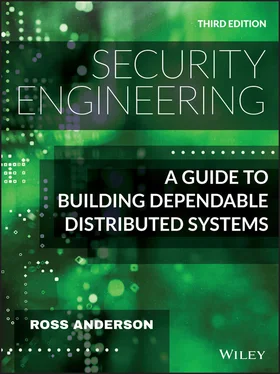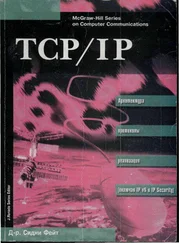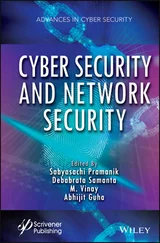6.4.5 Environmental creep
Many security failures result when environmental change undermines a security model. Mechanisms that worked adequately in an initial environment often fail in a wider one.
Access control mechanisms are no exception. Unix, for example, was originally designed as a ‘single user Multics’ (hence the name). It then became an operating system to be used by a number of skilled and trustworthy people in a laboratory who were sharing a single machine. In this environment the function of the security mechanisms is mostly to contain mistakes; to prevent one user's typing errors or program crashes from deleting or overwriting another user's files. The original security mechanisms were quite adequate for this purpose.
But Unix security became a classic ‘success disaster’. Over the 50 years since Ken Thomson started work on it at Bell Labs in 1969, Unix was repeatedly extended without proper consideration being given to how the protection mechanisms also needed to be extended. The Berkeley versions assumed an extension from a single machine to a network of machines that were all on one LAN and all under one management. The Internet mechanisms (telnet, ftp, DNS, SMTP) were originally written for mainframes on a secure network. Mainframes were autonomous, the network was outside the security protocols, and there was no transfer of authorisation. So remote authentication, which the Berkeley model really needed, was simply not supported. The Sun extensions such as NFS added to the party, assuming a single firm with multiple trusted LANs. We've had to retrofit protocols like Kerberos, TLS and SSH as duct tape to hold the world together. The arrival of billions of phones, which communicate sometimes by wifi and sometimes by a mobile network, and which run apps from millions of authors (most of them selfish, some of them actively malicious), has left security engineers running ever faster to catch up.
Mixing many different models of computation together has been a factor in the present chaos. Some of their initial assumptions still apply partially, but none of them apply globally any more. The Internet now has billions of phones, billions of IoT devices, maybe a billion PCs, and millions of organisations whose managers not only fail to cooperate but may be in conflict. There are companies that compete; political groups that despise each other, and nation states that are at war with each other. Users, instead of being trustworthy but occasionally incompetent, are now largely unskilled – but some are both capable and hostile. Code used to be simply buggy – but now there is a lot of malicious code out there. Attacks on communications used to be the purview of intelligence agencies – now they can be done by youngsters who've downloaded attack tools from the net and launched them without any real idea of how they work.
Access control mechanisms operate at a number of levels in a system, from the hardware up through the operating system and middleware like browsers to the applications. Higher-level mechanisms can be more expressive, but also tend to be more vulnerable to attack for a variety of reasons ranging from intrinsic complexity to implementer skill.
The main function of access control is to limit the damage that can be done by particular groups, users, and programs whether through error or malice. The most widely fielded examples are Android and Windows at the client end and Linux at the server end; they have a common lineage and many architectural similarities. The basic mechanisms (and their problems) are pervasive. Most attacks involve the opportunistic exploitation of bugs; products that are complex, widely used, or both are particularly likely to have vulnerabilities found and turned into exploits. Many techniques have been developed to push back on the number of implementation errors, to make it less likely that the resulting bugs give rise to vulnerabilties, and harder to turn the vulnerabilities into exploits; but the overall dependability of large software systems improves only slowly.
Most of the issues in access control were identified by the 1960s or early 1970s and were worked out on experimental systems such as Multics [1687] and the CAP [2024]. Much of the research in access control systems since then has involved reworking the basic themes in new contexts, such as mobile phones.
Recent threads of research include enclaves, and the CHERI mechanisms for adding finer-grained access control. Another question is: how will developers use such tools effectively?
In the second edition I predicted that ‘a useful research topic for the next few years will be how to engineer access control mechanisms that are not just robust but also usable – by both programmers and end users.’ Recent work by Yasemin Acar and others has picked that up and developed it into one of the most rapidly-growing fields of security research [11]. Many if not most technical security failures are due at least in part to the poor usability of the protection mechanisms that developers are expected to use. I already mention in the chapter on cryptography how crypto APIs often induce people to use really unsafe defaults, such as encrypting long messages with ECB mode; access control is just as bad, as anyone coming cold to the access control mechanisms in a Windows system or either an Intel or Arm CPU will find.
As a teaser, here's a new problem. Can we extend what we know about access control at the technical level – whether hardware, OS or app – to the organisational level? In the 20th century, there were a number of security policies proposed, from Bell-LaPadula to Clark-Wilson, which we discuss at greater length in Part 2. Is it time to revisit this for a world of deep outsourcing and virtual organisations, now that we have interesting technical analogues?
There's a history of virtualisation and containers by Allison Randal at [1578]; a discussion of how mandatory access controls were adapted to operating systems such as OS X and iOS by Robert Watson in [1997]; and a reference book for Java security written by its architect Li Gong [784]. The Cloud Native Security Foundation is trying to move people towards better open-source practices around containers and other technologies for deploying and managing cloud-native software. Going back a bit, the classic descriptions of Unix security are by Fred Grampp and Robert Morris in 1984 [806] and by Simson Garfinkel and Eugene Spafford in 1996 [753], while the classic on Internet security by Bill Cheswick and Steve Bellovin [222] gives many examples of network attacks on Unix systems.
Carl Landwehr gives a useful reference to many of the flaws found in operating systems in the 1960s through the 1980s [1131]. One of the earliest reports on the subject (and indeed on computer security in general) is by Willis Ware in 1970 [1990]; Butler Lampson's seminal paper on the confinement problem appeared in 1970s [1127] and three years later, another influential early paper was written by Jerry Saltzer and Mike Schroeder [1642]. The textbook we get our students to read on access control issues is Dieter Gollmann's ‘Computer Security’ [780]. The standard reference on Intel's SGX and indeed its CPU security architecture is by Victor Costan and Srini Devadas [479].
The field of software security is fast-moving; the attacks change significantly (at least in their details) from one year to the next. The classic starting point is Gary McGraw's 2006 book [1268]. Since then we've had ROP attacks, Spectre and much else; a short but useful update is Matthias Payer's Software Security [1506]. But to really keep up, it's not enough to just read textbooks; you need to follow security conferences such as Usenix and CCS as well as the security blogs such as Bruce Schneier, Brian Krebs and – dare I say it – our own lightbluetouchpaper.org. The most detail on the current attacks is probably in Google's Project Zero blog; see for example their analysis of attacks on iPhones found in the wild for an insight into what's involved in hacking modern operating systems with mandatory access control components [205].
Читать дальше











